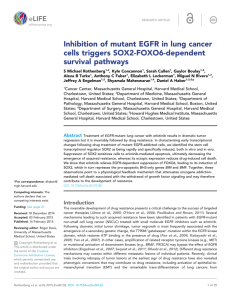Identification a Novel Regulatory Mechanism Governing One of the
advertisement
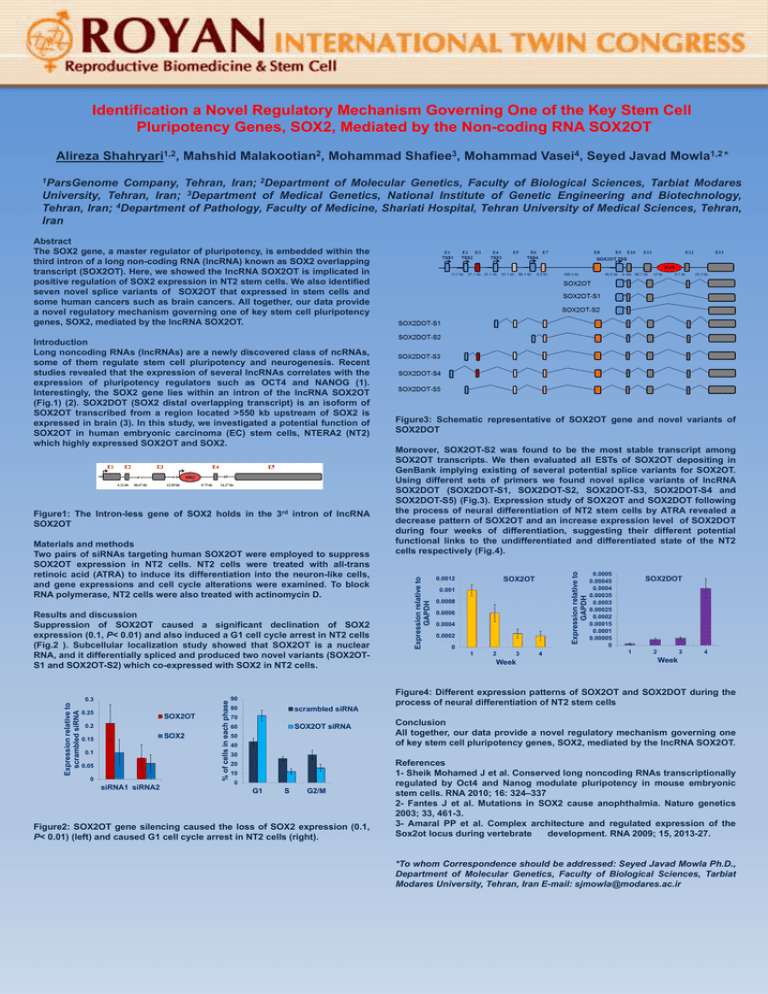
Identification a Novel Regulatory Mechanism Governing One of the Key Stem Cell Pluripotency Genes, SOX2, Mediated by the Non-coding RNA SOX2OT Alireza Shahryari1,2, Mahshid Malakootian2, Mohammad Shafiee3, Mohammad Vasei4, Seyed Javad Mowla1,2* 1ParsGenome Company, Tehran, Iran; 2Department of Molecular Genetics, Faculty of Biological Sciences, Tarbiat Modares University, Tehran, Iran; 3Department of Medical Genetics, National Institute of Genetic Engineering and Biotechnology, Tehran, Iran; 4Department of Pathology, Faculty of Medicine, Shariati Hospital, Tehran University of Medical Sciences, Tehran, Iran Abstract The SOX2 gene, a master regulator of pluripotency, is embedded within the third intron of a long non-coding RNA (lncRNA) known as SOX2 overlapping transcript (SOX2OT). Here, we showed the lncRNA SOX2OT is implicated in positive regulation of SOX2 expression in NT2 stem cells. We also identified seven novel splice variants of SOX2OT that expressed in stem cells and some human cancers such as brain cancers. All together, our data provide a novel regulatory mechanism governing one of key stem cell pluripotency genes, SOX2, mediated by the lncRNA SOX2OT. Materials and methods Two pairs of siRNAs targeting human SOX2OT were employed to suppress SOX2OT expression in NT2 cells. NT2 cells were treated with all-trans retinoic acid (ATRA) to induce its differentiation into the neuron-like cells, and gene expressions and cell cycle alterations were examined. To block RNA polymerase, NT2 cells were also treated with actinomycin D. Expression relative to scrambled siRNA 0.3 0.25 SOX2OT 0.2 SOX2 0.15 0.1 0.05 0 siRNA1 siRNA2 % of cells in each phase Results and discussion Suppression of SOX2OT caused a significant declination of SOX2 expression (0.1, P< 0.01) and also induced a G1 cell cycle arrest in NT2 cells (Fig.2 ). Subcellular localization study showed that SOX2OT is a nuclear RNA, and it differentially spliced and produced two novel variants (SOX2OTS1 and SOX2OT-S2) which co-expressed with SOX2 in NT2 cells. 90 80 scrambled siRNA 70 SOX2OT siRNA 60 50 40 Moreover, SOX2OT-S2 was found to be the most stable transcript among SOX2OT transcripts. We then evaluated all ESTs of SOX2OT depositing in GenBank implying existing of several potential splice variants for SOX2OT. Using different sets of primers we found novel splice variants of lncRNA SOX2DOT (SOX2DOT-S1, SOX2DOT-S2, SOX2DOT-S3, SOX2DOT-S4 and SOX2DOT-S5) (Fig.3). Expression study of SOX2OT and SOX2DOT following the process of neural differentiation of NT2 stem cells by ATRA revealed a decrease pattern of SOX2OT and an increase expression level of SOX2DOT during four weeks of differentiation, suggesting their different potential functional links to the undifferentiated and differentiated state of the NT2 cells respectively (Fig.4). Expression relative to GAPDH Figure1: The Intron-less gene of SOX2 holds in the 3rd intron of lncRNA SOX2OT Figure3: Schematic representative of SOX2OT gene and novel variants of SOX2DOT Expression relative to GAPDH Introduction Long noncoding RNAs (lncRNAs) are a newly discovered class of ncRNAs, some of them regulate stem cell pluripotency and neurogenesis. Recent studies revealed that the expression of several lncRNAs correlates with the expression of pluripotency regulators such as OCT4 and NANOG (1). Interestingly, the SOX2 gene lies within an intron of the lncRNA SOX2OT (Fig.1) (2). SOX2DOT (SOX2 distal overlapping transcript) is an isoform of SOX2OT transcribed from a region located >550 kb upstream of SOX2 is expressed in brain (3). In this study, we investigated a potential function of SOX2OT in human embryonic carcinoma (EC) stem cells, NTERA2 (NT2) which highly expressed SOX2OT and SOX2. SOX2OT 0.0012 0.001 0.0008 0.0006 0.0004 0.0002 0 1 2 3 Week 4 0.0005 0.00045 0.0004 0.00035 0.0003 0.00025 0.0002 0.00015 0.0001 0.00005 0 SOX2DOT 1 2 3 4 Week Figure4: Different expression patterns of SOX2OT and SOX2DOT during the process of neural differentiation of NT2 stem cells Conclusion All together, our data provide a novel regulatory mechanism governing one of key stem cell pluripotency genes, SOX2, mediated by the lncRNA SOX2OT. 30 20 10 0 G1 S G2/M Figure2: SOX2OT gene silencing caused the loss of SOX2 expression (0.1, P< 0.01) (left) and caused G1 cell cycle arrest in NT2 cells (right). References 1- Sheik Mohamed J et al. Conserved long noncoding RNAs transcriptionally regulated by Oct4 and Nanog modulate pluripotency in mouse embryonic stem cells. RNA 2010; 16: 324–337 2- Fantes J et al. Mutations in SOX2 cause anophthalmia. Nature genetics 2003; 33, 461-3. 3- Amaral PP et al. Complex architecture and regulated expression of the Sox2ot locus during vertebrate development. RNA 2009; 15, 2013-27. *To whom Correspondence should be addressed: Seyed Javad Mowla Ph.D., Department of Molecular Genetics, Faculty of Biological Sciences, Tarbiat Modares University, Tehran, Iran E-mail: sjmowla@modares.ac.ir
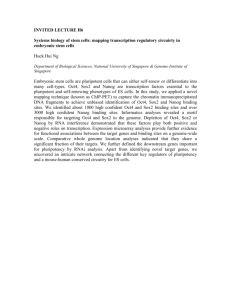
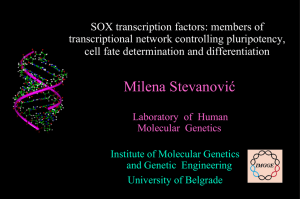
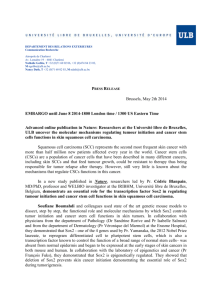
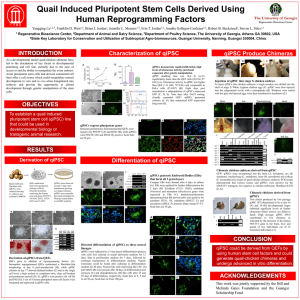
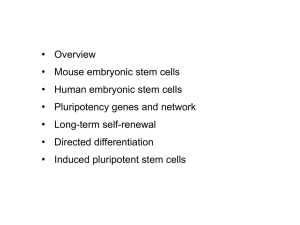


![Amir Shams [ card ] 02](http://s2.studylib.net/store/data/005340099_1-e713f7ae67edd60d4c53ae5bb9448166-300x300.png)



